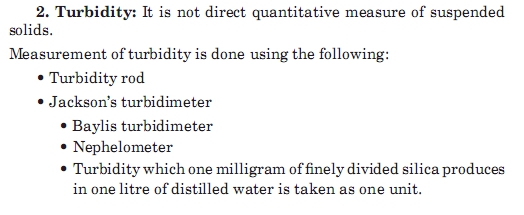Self Purification of Stream
A polluted stream undergoes self-purification
- Zone A – Zone of clear water
- Zone B – Zone of Degradation
- Zone C – Zone of Active decomposition
- Zone D – Zone of Recovery
- Zone E – Zone of recovery
Zone | Main Characteristics |
Zone of Clear Water (1 & 5) | Clear water, presence of fishes. 100% saturation |
Zone of Degradation (2) | Dissolved oxygen level falls due to the decomposition of Organic Matter in this Zone. Dark and turbid water. Fishes may present Algae are absent. 40% saturation |
Zone of Active Decomposition (3) | Zone of heavy pollution. Water is very dark and turbid Dissolved oxygen level falls to Zero. Critical Oxygen Deficient occurs. Formation of the dirty scum layer. Both fishes and algae absents 0% saturation |
Zone of recovery (4) | Dissolved oxygen level increases and may reach to saturated value. Decomposition of organic matter takes place up to the Nitrate level. Both fishes and Algae reappear. BOD falls down. 40% saturation |
Purification of sewage in river
When sewage or sewage effluents are discharged into the river, river gets polluted temporary, but the conditions do not remain so forever, because the natural forces of purification such as dilution, sedimentation, oxidation, reduction in sunlight go on acting upon the pollutants and bring back the water into its original condition. This process known as self purification and various forces responsible for this are described briefly below:
1. Dilution and Dispersion:
- When sewage is discharged into large volume of river water, it gets rapidly dispersed and diluted. This results in reduction of concentration of organic matter in sewage.
2. Sedimentation:
- The suspended solids in sewage gets settle down into the river bed by the action of gravity.
3. Oxidation:
- The organic matter present in sewage gets oxidized by the microorganisms with the help of dissolved oxygen present in river and results in formation of stable products.
4. Reduction:
- It occurs due to hydrolysis of organic matter settles down at the bottom of river bed either chemically or biologically.
The above natural forces of purification depend on various factors which are:
- 3. Velocity of river stream
- 4. Availability of dissolved oxygen
- 5. Type and amount of organic matter present
Important Terms
Hydrolysis:
- It is a chemical process in which a molecule is cleaved into two parts by the addition of a molecule of water. One fragment of the parent molecule gains a hydrogen ion (H+) from the additional water molecule. The other group collects the remaining hydroxyl group (OH-).
Pyrolysis
- It is the process in which the most of organic matter upon heating in an oxygen free atmosphere splits through a combination of thermal cracking and condensation reactions into gaseous, liquid and solid fractions.
- The process typically occurs at temperatures above 430 °C (800 °F) and under pressure. It simultaneously involves the change of physical phase and chemical composition and is an irreversible process. So it is an endothermic process.


















